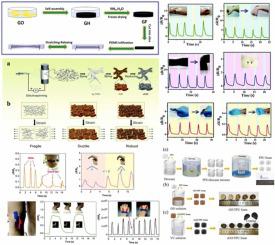Sensors and Actuators A: Physical ( IF 4.6 ) Pub Date : 2022-07-16 , DOI: 10.1016/j.sna.2022.113767 Qinhua Hu , Anindya Nag , Lijuan Zhang , Kuaishe Wang

|
The exceptional electromechanical attributes of graphene have led to its usage in pure and composite forms for different kinds of biomedical and industrial applications. Among the various physiochemical allotropes of graphene employed to form flexible sensors, reduced graphene oxide (rGO) has been preferred due to the easier process of fabrication and an ability to disperse uniformly in water and other organic solvents. This paper reports some of the significant work done on the use of rGO/polymer-based composites for strain-sensing applications. A classification has been implemented in terms of nature, the polymers being integrated with rGO to form the resultant sensors. The use of two types of polymers, including polydimethylsiloxane (PDMS) and thermoplastic polyurethane (TPU), have been shown in this paper. PDMS and TPU have been largely employed to form wearable sensors due to the mechanical advantages imparted by them. These polymers have either been used as substrates or as polymer matrices to mix with rGO and other nanomaterials at optimized ratios. Some of the existing challenges and the possible remedial solutions of the current rGO/PDMS-based strain sensors have been showcased here.
中文翻译:

用于可穿戴应变传感应用的还原氧化石墨烯基复合材料
石墨烯卓越的机电特性导致其以纯和复合形式用于不同种类的生物医学和工业应用。在用于形成柔性传感器的石墨烯的各种物理化学同素异形体中,还原氧化石墨烯 (rGO) 因其更容易的制造过程和均匀分散在水和其他有机溶剂中的能力而受到青睐。本文报告了在应变传感应用中使用 rGO/聚合物基复合材料所做的一些重要工作。已经根据性质实施了分类,聚合物与 rGO 集成以形成最终的传感器。本文展示了两种聚合物的使用,包括聚二甲基硅氧烷 (PDMS) 和热塑性聚氨酯 (TPU)。由于它们赋予的机械优势,PDMS 和 TPU 已被广泛用于形成可穿戴传感器。这些聚合物要么用作基材,要么用作聚合物基质,以优化比例与 rGO 和其他纳米材料混合。此处展示了当前基于 rGO/PDMS 的应变传感器的一些现有挑战和可能的补救解决方案。


























 京公网安备 11010802027423号
京公网安备 11010802027423号